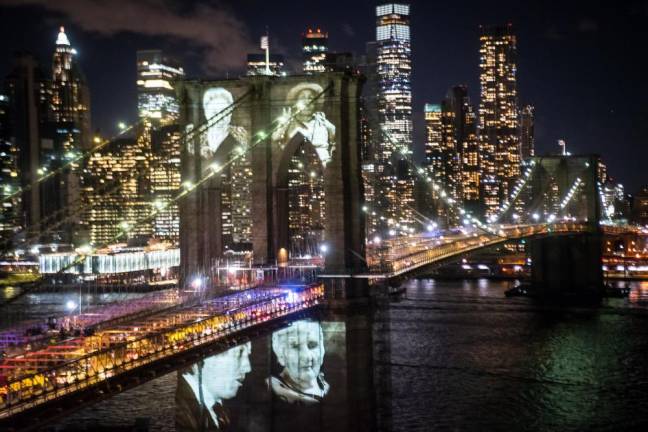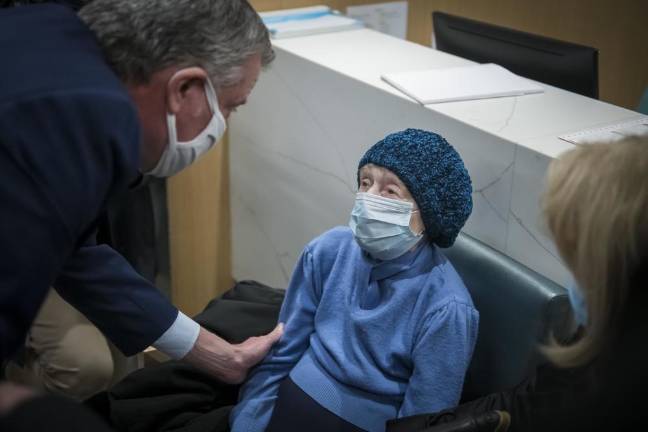Hope cometh in many forms. A 30-second TV spot is hardly the most common. Yet last week it was unmistakable.
“One year ago, our show was hours away from opening,” the announcer shares, “then Broadway shut down.”
That show was “Six,” a musical, if you can believe it, featuring the six singing wives of Henry the VIII.
For “Six,” March 12, 2020, was the opening night that wasn’t.
The stage was set. The red carpet was rolled out, the after party was planned. And then, darkness....
The core genius of New York City has always been its capacity to transform trauma into hope and challenge into opportunity - a capacity honed into art in that singular New York form, the Broadway musical.
So, it was fitting, to say nothing of memorable, that amidst all the marking of this first anniversary of the pandemic what rose up was an ad for a Broadway show.
“The past year has been beyond challenging for everyone. But we will all get through it because we are unbreakable.”
(“Unbreakable” being the ballad in the show where Jane Seymour declares her resilience in the face of King Henry’s shifting attentions.)
“And when New York is ready we will see you back on Broadway.”
Some may bridle at this commercialization of our collective pain to lure butts into seats as fast as we can after shots in arms.
But, hey, that IS New York. The commercial “Island at the Center of the World” chronicled by author Russell Shorto.
“What We Remember”
New Yorkers have been the alchemists of the modern age, for whom making gold from straw is all in a day’s work. Again and again, since our Dutch founding, New York has transformed the poor, the tired and the huddled flotsam of a broken world, into free-breathing entrepreneurs, whether they were driving a cab or putting on a Broadway show (or perhaps the one while planning the other).
New York offered Emma Lazarus’s “golden door” to generations seeking refuge from tribulations. Even, as Langston Hughes so pointedly put it, “In the face of what we remember.”
But this time is different. This is not a calamity we can run from. This happened TO New Yorkers. We are the island at the epicenter of the world.
The numbers are frightening. Three-quarters of a million New Yorkers have tested positive for the Sar-Cov2 virus in the past year or shown symptoms of COVID-19, the city’s health department reports. Of those, nearly 100,000 were hospitalized and 30,000 died.
Tally of Suffering
That is the beginning, not the end, of the tally of suffering. Those with less suffered more, medically and economically. Entire sectors of the economy went dark and have yet to relight, Broadway theater prominent among them.
What was touching about the message from the producers of “Six,” many of them, ironically, British, was how well it distilled the struggle of every New Yorker to begin to make sense of this past year so we can move forward.
The question “where were you last March,” replaced “where were you on 9/11” as a touchpoint for this time without touching. This was about more than just sharing pain. This first anniversary of the pandemic also became the beginnings of emerging from it.
“The thing I remember most about this week last year,” recalled Garance Franke-Ruta, Executive Editor of the magazine Gen on Medium, “was all the useless public health advice we were given...”
The fog is summed up in Franke-Ruta’s memory of how she elbow-bumped a friend on March 12 at a “not even yet reduced-occupancy restaurant and then sat down inside to talk with her at the bar.”
The wars over masks were still in our future that day, even as relentless wiping of every surface has receded into the past.
Big Lessons
President Biden marked the first anniversary expressing hope that his American Rescue Plan and the vaccination campaign would restore faith in the power of government to help, a resonant argument in the city where the New Deal was invented to lift us out of an earlier crisis.
But as Franke-Ruta’s memory illustrates, the pandemic has left us with a deep well of worry about what experts and governments tell us.
There are big lessons in this that we have not begun to take in. Following the science sounds smart, but the heart of science is uncertainty and doubt.
If we truly mean to follow the science, the scientists will have to do a better job of explaining their uncertainties, government leaders will have to let them and we, as citizens, will have to accept doubt – that vast space of what we don’t know – as the inevitable companion of what we do know, or think we know, in the moment.
This is more than an online epistemology class to fill the lockdown hours.
Recovery will require realism. March 12 was the busiest day since the pandemic on New York’s subways, an economic green shoot if one can use that image for a crowded A train. One out of five New Yorkers have received at least one dose of vaccine. Baseball, with fans, outdoors, opens April 1 in the Bronx and April 8 in Queens.
Yet “Six” still doesn’t have a new opening night. Broadway performers took to Duffy Square on Friday determined to show their singing and hoofing could surround coronavirus and force it to surrender.
“The shutdown of Broadway for many marked the beginning of the pandemic,” said Tom Harris, acting president of the Times Square Alliance. “As we cross the one-year mark, we are reminded of what we lost, how far we have come, and how much work we need to do to fully recover.”
Russell Shorto wrote that “Manhattan is where America began.” By stepping away from empires of the past, New Yorkers invented something new.
We can’t just step away this time, because we are the island at the center of this storm. But perhaps New York’s creative energy can help the world begin anew. “Shoulder to shoulder, one for another,” Mayor Bill de Blasio said at a memorial service Sunday night, “we will bring our city back together.”
Three-quarters of a million New Yorkers have tested positive for the Sar-Cov2 virus in the past year or shown symptoms of COVID-19, the city’s health department reports. Of those, nearly 100,000 were hospitalized and 30,000 died.

